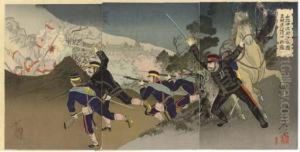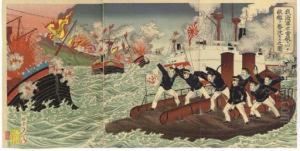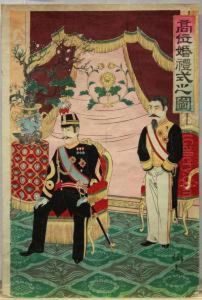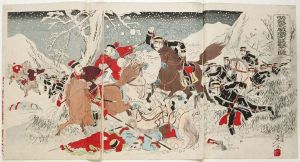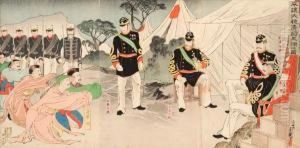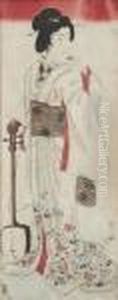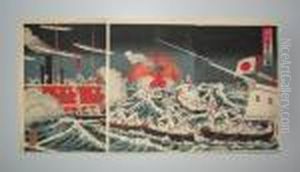Watanabe Nobukazu Paintings
Watanabe Nobukazu was a Japanese woodblock print artist active during the Meiji era, a period of rapid modernization and westernization in Japan. Born in 1872, Nobukazu was part of the Ukiyo-e tradition, a genre of Japanese art that flourished between the 17th and 19th centuries, known for its beautiful depictions of female beauties, kabuki actors, sumo wrestlers, scenes from history and folk tales, travel scenes and landscapes, flora and fauna, and erotica. While the exact details of his early life and training are not well-documented, it is known that he worked within the Ukiyo-e tradition, adapting its themes and techniques to appeal to the changing tastes of the Meiji period.
Nobukazu's work is characterized by its vibrant colors, dynamic compositions, and the incorporation of Western perspective and techniques, reflecting the cultural and technological shifts occurring in Japan at the time. He produced a wide range of prints, including multi-panel scenes of battles and historical events, which were particularly popular due to the nationalistic fervor of the era. Nobukazu also created prints depicting the Sino-Japanese War (1894-1895) and Russo-Japanese War (1904-1905), contributing to the genre of senso-e (war prints) that celebrated Japanese military victories.
Despite his prolific output and the popularity of his works during his lifetime, Watanabe Nobukazu's legacy is somewhat overshadowed by that of his contemporaries and predecessors, such as the great masters of Ukiyo-e like Hokusai and Hiroshige. However, his work provides valuable insight into the cultural and social changes in Japan during the Meiji period. Nobukazu continued to produce art until his death in 1944, towards the end of World War II, a period that marked significant challenges and transformations for Japan.
Today, Nobukazu's prints are appreciated for their historical value and artistry, offering a window into the Meiji era's aesthetics and societal shifts. His contributions to the Ukiyo-e tradition and Japanese art history, though not as widely recognized as those of some of his peers, remain an important part of the study of Meiji-era art and culture.
